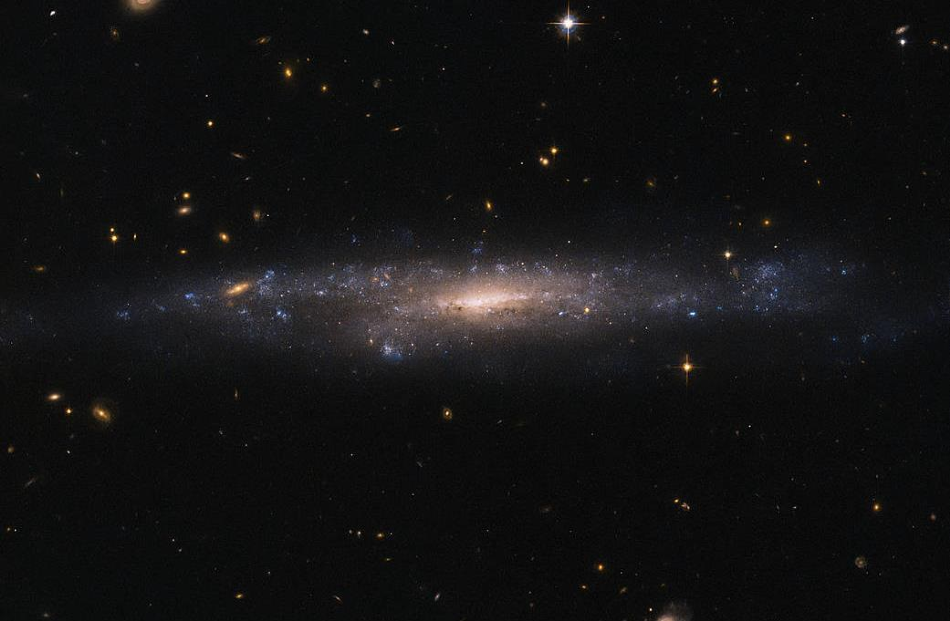Dec 19 2019
Low-surface-brightness galaxies have helped in acquiring new data and reaching significant conclusions on dark matter, which is one of the biggest mysteries of the cosmos.
 NASA/ESA Hubble Space Telescope image capturing UGC 477, a low surface brightness galaxy located just over 110 million light-years away in the constellation of Pisces (The Fish). Image Credit: ESA/Hubble and NASA; Acknowledgement: Judy Schmidt.
NASA/ESA Hubble Space Telescope image capturing UGC 477, a low surface brightness galaxy located just over 110 million light-years away in the constellation of Pisces (The Fish). Image Credit: ESA/Hubble and NASA; Acknowledgement: Judy Schmidt.
Scuola Internazionale Superiore di Studi Avanzati (SISSA) has now performed a new study that offers crucial data on the composition and interaction of dark matter with luminous matter.
We have found that disc galaxies can be represented by a universal relationship. In particular, in this study we analysed the so-called Low-Surface-Brightness (LSB) galaxies, a particular type of galaxy with a rotating disc called this way because they have a low-density brightness.
Chiara di Paolo, Study Lead Author and Astrophysicist, SISSA
Along with Paolo Salucci, an astrophysicist at SISSA, and Erkurt Adnan from Istanbul University, Paolo has recently reported the study in the Monthly Notices of the Royal Astronomical Society (MNRAS).
The scientists examined the rate at which gases and stars composing the galaxies, the study’s subject matter, rotate. They observed that the LSBs also exhibit a highly uniform behavior. Such an outcome consolidates many clues on the behavior and presence of dark matter and reveals novel scenarios on its communications with bright matter.
Lights and Shadows on Matter
Dark matter is there but cannot be seen. It appears to account for about 90% of the Universe’s mass; dark matter has impacts that can be identified on the other objects existing in the cosmos, but it cannot be directly visualized because it does not release light (at least for the manner in which it has been looked so far).
The rotation curves of the galaxies are one of the techniques for analyzing dark matter. These systems elucidate the trend of the stars’ speed depending on their distance from the galaxy center.
The differences that are seen are linked to the gravitational interactions because of the existence of stars, and also linked to the dark component of matter. As a result, the rotation curves provide an excellent method to obtain data on the dark matter based on its impacts on what could be potentially observed.
Specifically, the rotation curves can be analyzed separately or on groups of galaxies sharing analogous properties as per the universal rotation curve (URC) technique.
The study’s novelty lies in using the URC technique—which has already been applied for other kinds of galaxies—for the very first time to a massive sample of low-surface-brightness galaxies, acquiring analogous results.
We have compared rotation curves of various LSB galaxies finding that there is no discontinuity but gradual and ordered variations starting from the small to the large. Something similar was also observed for spiral galaxies.
Paolo Salucci, Study Co-Author, Astrophysicist, SISSA
Salucci continued, “This method was applied for the first time in 1996, and to date it has shown that all disc, spiral, dwarf and now also the LSB galaxies can be represented by a universal relationship.”
“This means that we are able to express an ordered trend through a formula which, keeping account of very few parameters, describes how dark matter and luminous matter are distributed,” added Salucci.
New Possible Scenarios
As is usually the case in scientific research, the study has demonstrated more unexpected and surprising outcomes.
We have discovered relationships of scale between the properties of the stellar disc and those of the dark matter halo, for example a relationship between the dimensions of the stellar discs and the dimensions of the internal region with a constant density of the dark matter halo.
Chiara di Paolo, Study Lead Author and Astrophysicist, SISSA
Chiara di Paolo continued, “Furthermore, by comparing the relationships found in the LSB with those obtained in different types of galaxies, we have found that they are all almost coincidental. And it has been a great surprise to verify that galaxies with a very different morphology and history show the same relationships between the properties of dark matter and those of luminous matter.”
This outcome, along with a few particular features of LSB galaxies, paves the way to a new line of circumstances, including that of the presence of another type of direct interaction, apart from the gravitational one that exists between the two kinds of matter forming galaxies. This is an interesting concept to be validated by the latest observations.